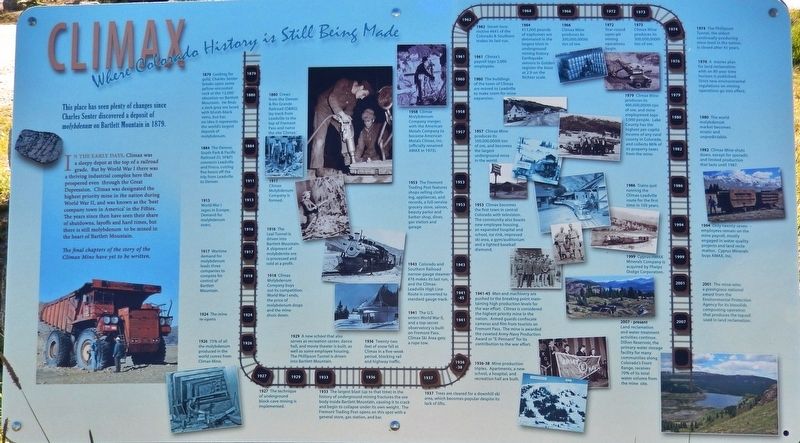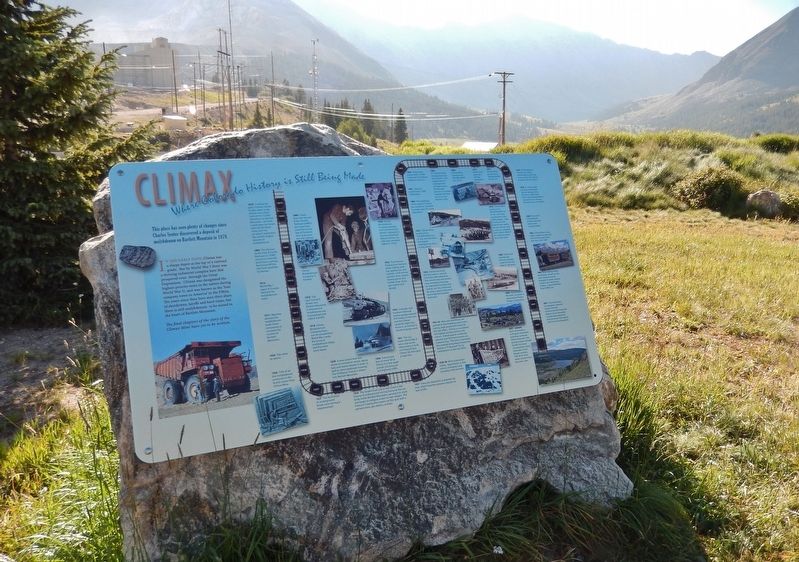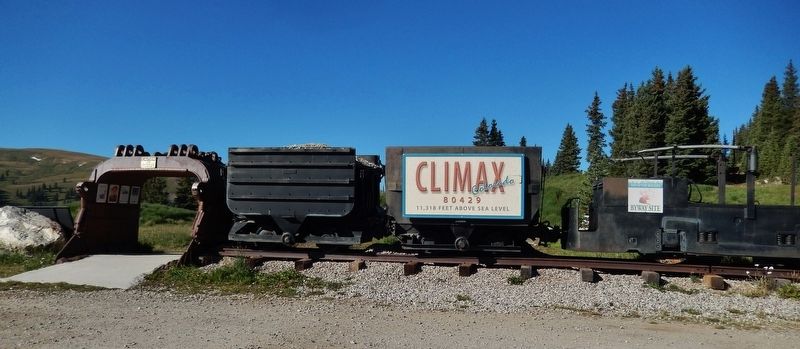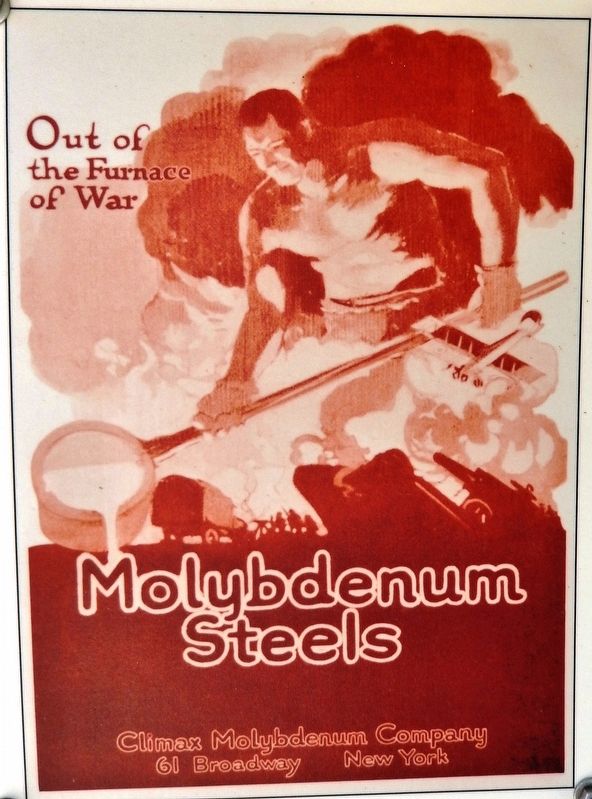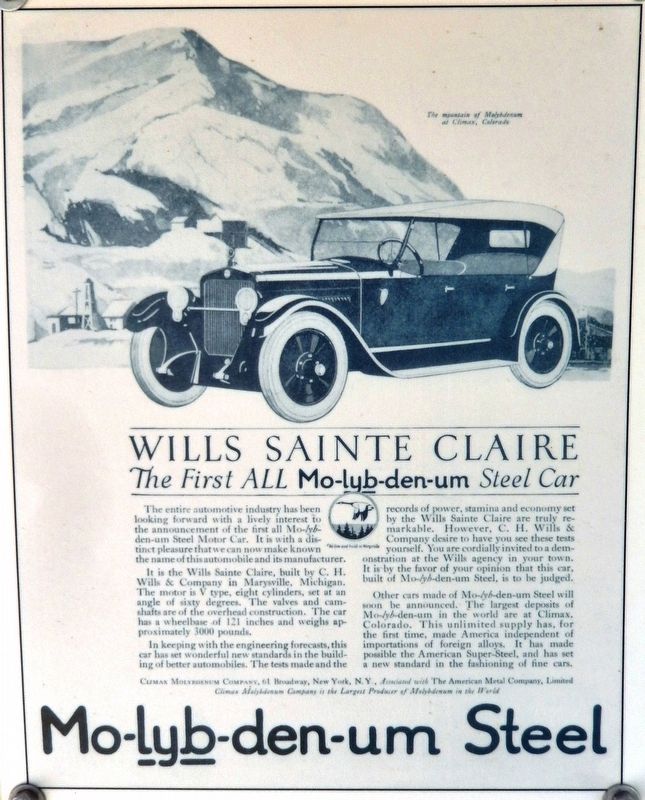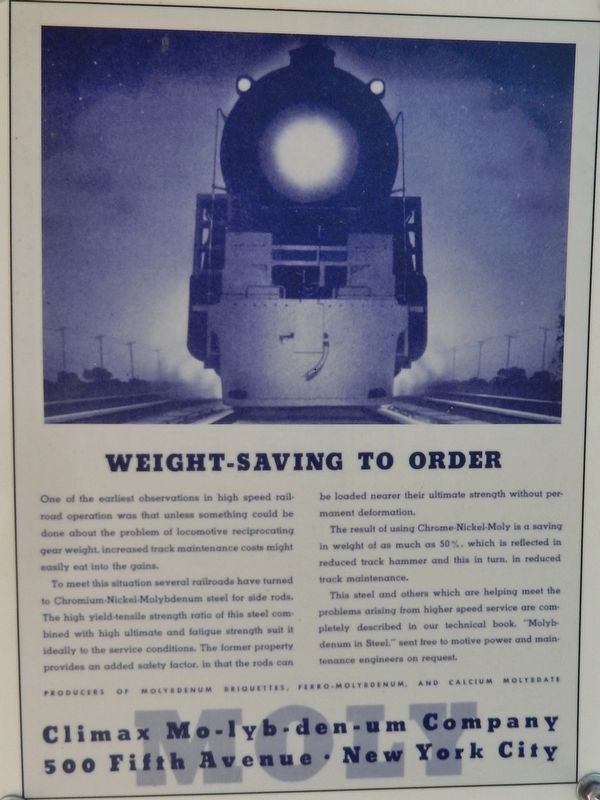Climax in Lake County, Colorado — The American Mountains (Southwest)
Climax
Where Colorado History is Still Being Made
In the early days, Climax was a sleepy depot at the top of a railroad grade. But by World War I there was a thriving industrial complex here that prospered even through the Great Depression. Climax was designated the highest priority mine in the nation during World War II, and was known as the “best company town in America” in the Fifties. The years since then have seen their share of shutdowns, layoffs and hard times, but there is still molybdenum to be mined in the heart of Bartlett Mountain.
The final chapters of the story of the Climax Mine have yet to be written.
1879 Looking for gold. Charles Senter breaks open some yellow encrusted rock at the 12,000 elevation on Bartlett Mountain. He finds dark grey ore laced with bluish-black veins, but has no idea it represents the world's largest deposit of molybdenum.
1880 Crews from the Denver Rio Grande Railroad (D&RG) lay track from Leadville to the top of Fremont name the site “Climax.”
1884 The Denver, South Park & Pacific Railroad (D, SP&P) connects Leadville and Frisco, cutting five hours off the trip from Leadville to Denver.
1911 Climax Molybdenum Company is formed.
1913 World War I rages in Europe. Demand for molybdenum soars.
1916 The Leal Tunnel driven into Bartlett Mountain. A shipment of molybdenite ore is processed and sold at a profit.
1917 Wartime demand for molybdenum leads three companies to compete for control of Bartlett Mountain.
1918 Climax Molybdenum Company buys out its competition. World War I ends, the price of molybdenum drops and the mine shuts down.
1924 The mine re-opens.
1926 75% of all the molybdenum produced in the world comes from Climax Mine.
1927 The technique of underground block-cave mining is implemented.
1929 A new school that also serves as recreation center, dance hall, and movie theater is built, as well as some employee housing. The Phillipson Tunnel is driven Into Bartlett Mountain.
1933 The largest blast (up to that time) in the history of underground mining fractures the ore body inside Bartlett Mountain, causing it to crack and begin to collapse under its own weight. The Fremont Trading Post opens on this spot with a general store, gas station, and bar.
1936 Twenty-two feet of snow fall at Climax in a five-week period, blocking rail and highway traffic.
1937 Trees are cleared for a downhill ski area, which becomes popular despite its lack of lifts.
1936-38 Mine production triples. Apartments, a new school, a hospital, and recreation hall are built.
1941 The U.S. enters World War II, and a top-secret observatory is built on Fremont Pass. Climax Ski Area gets a rope tow.
1941-45 Men and machinery are pushed to the breaking point maintaining high production levels for the war effort. Climax is considered the highest priority mine in the nation. Armed guards confiscate cameras and film from tourists on Fremont Pass. The mine is awarded the coveted Army-Navy Production Award or “E-Pennant” for its contribution to the war effort.
1943 Colorado and Southern Railroad narrow-gauge steamer #76 makes its last run, and the Climax-Leadville High Line Route is converted to standard gauge track.
1953 1953 Climax becomes the first town in central Colorado with television. The community also boasts new employee housing, an expanded hospital and school, ice rink, improved ski area, a gym/auditorium and a lighted baseball diamond.
1953 The Fremont Trading Post features shops selling clothing, appliances, and records, a full-service grocery store, saloon, beauty parlor and barber shop, diner, gas station and garage.
1957 Climax Mine produces its 100,000,000th ton of ore, and becomes the largest
underground mine in the world.
1958 Climax Molybdenum Company merges with the American Metals Company to become American Metals Climax, Inc. (officially renamed AMAX In 1973).
1960 The buildings of the town of Climax are moved to Leadville to make room for mine expansion.
1961 Climaxs payroll tops 2,000 employees.
1962 Steam locomotive #641 of the Colorado & Southern makes its last run.
1964 417,000 pounds of explosives are detonated in the largest blast in underground mining history. Earthquake sensors in Golden register the blast at 2.9 on the Richter scale.
1966 Climax Mine produces its 200,000,000th ton of ore.
1972 Year round open pit mining operations begin.
1973 Climax Mine produces Its 300,000,000th ton of ore.
1974 The Phillipson Tunnel, the oldest continually-producing mine level in the nation, is closed after 41 years.
1976 A master plan for land reclamation with an 80-year time horizon is published. Strict new environmental regulations on mining operations go into effect.
1979 Climax Mine produces Its 400,000,000th ton of ore, and mine employment tops 3,000 people. Lake County has the highest per-capita income of any rural county in Colorado, and collects 86% of its property taxes from the mine.
1980
The world molybdenum market becomes erratic and unpredictable.
1982 Climax Mine shuts down, except for sporadic and limited production that lasts until 1987.
1986 Trains quit running the Climax-Leadville route for the first time in 105 years.
1994 Only twenty-seven employees remain on the mine payroll, mostly engaged in water quality projects and land reclamation. Cyprus Minerals buys AMAX, Inc.
1999 Cyprus-AMAX Minerals Company is acquired by Phelps Dodge Corporation.
2001 The mine wins a prestigious national award from the Environmental Protection Agency for its biosolids composting operation that produces the topsoil used in land reclamation.
2007-present Land reclamation and water treatment activities continue. Dillon Reservoir, the primary water storage facility for many communities along Colorado's Front Range, receives 70% of its total water volume from the mine site.
Erected by Climax Molybdenum Company & the Federal Highway Administration.
Topics. This historical marker is listed in these topic lists: Environment • Industry & Commerce • Settlements & Settlers.
Location. 39° 22.041′ N, 106° 11.299′ W. Marker is in Climax, Colorado, in
Lake County. Marker can be reached from State Highway 91, 11 miles south of Interstate 70, on the right when traveling south. Marker is located on the west side of Colorado Highway 91, at the summit of Fremont Pass, directly across from the Climax Molybdenum Mine, within a small park containing historical markers and mining exhibits. Touch for map. Marker is in this post office area: Climax CO 80429, United States of America. Touch for directions.
Other nearby markers. At least 8 other markers are within walking distance of this marker. Welcome to Climax! (a few steps from this marker); The Big Shot (a few steps from this marker); Life on the High Line (within shouting distance of this marker); Highway in the Sky (within shouting distance of this marker); Water Treatment Protects Downstream Users (within shouting distance of this marker); The Highest Compost Pile in the World (within shouting distance of this marker); Skiing on Top of the World (within shouting distance of this marker); More Than Just a Mine (within shouting distance of this marker). Touch for a list and map of all markers in Climax.
More about this marker. Marker is a large composite plaque, mounted on a large boulder.
Related markers. Click here for a list of markers that are related to this marker. Climax Historical Park
Credits. This page was last revised on September 5, 2018. It was originally submitted on September 2, 2018, by Cosmos Mariner of Cape Canaveral, Florida. This page has been viewed 453 times since then and 47 times this year. Photos: 1, 2, 3, 4, 5, 6. submitted on September 3, 2018, by Cosmos Mariner of Cape Canaveral, Florida. • Andrew Ruppenstein was the editor who published this page.
